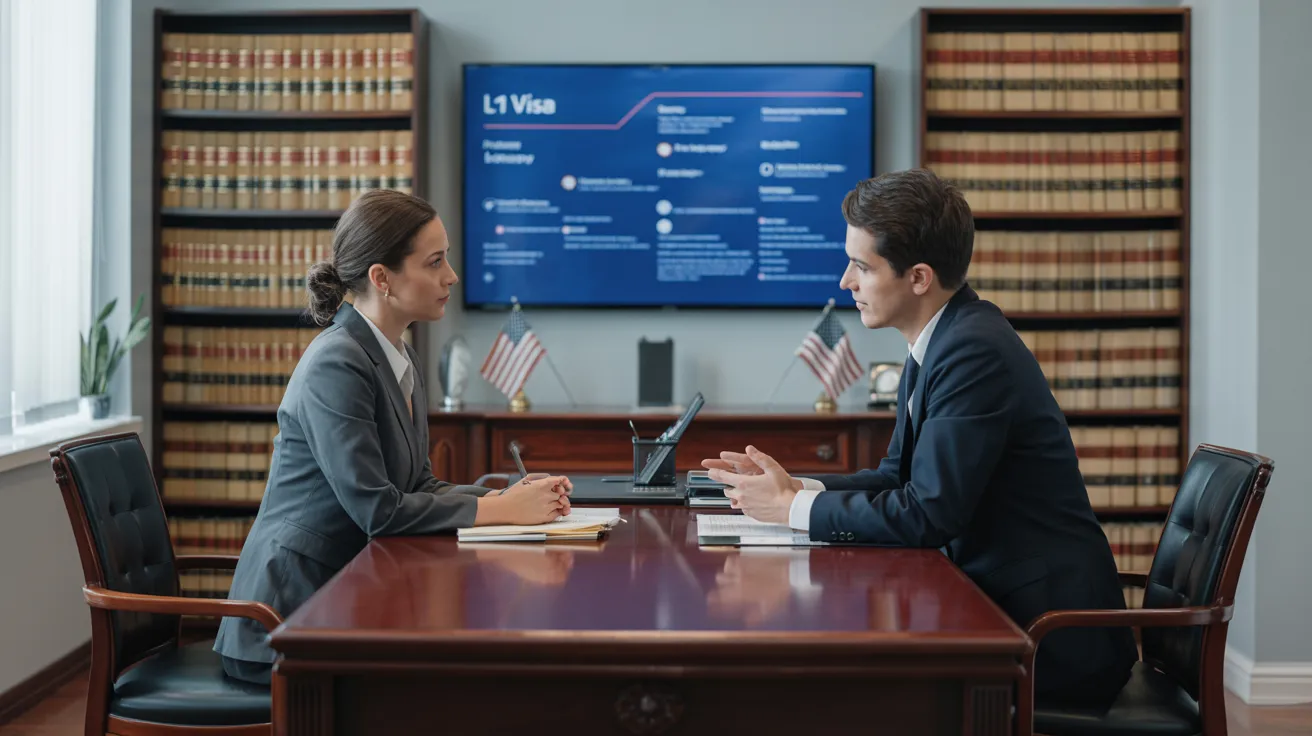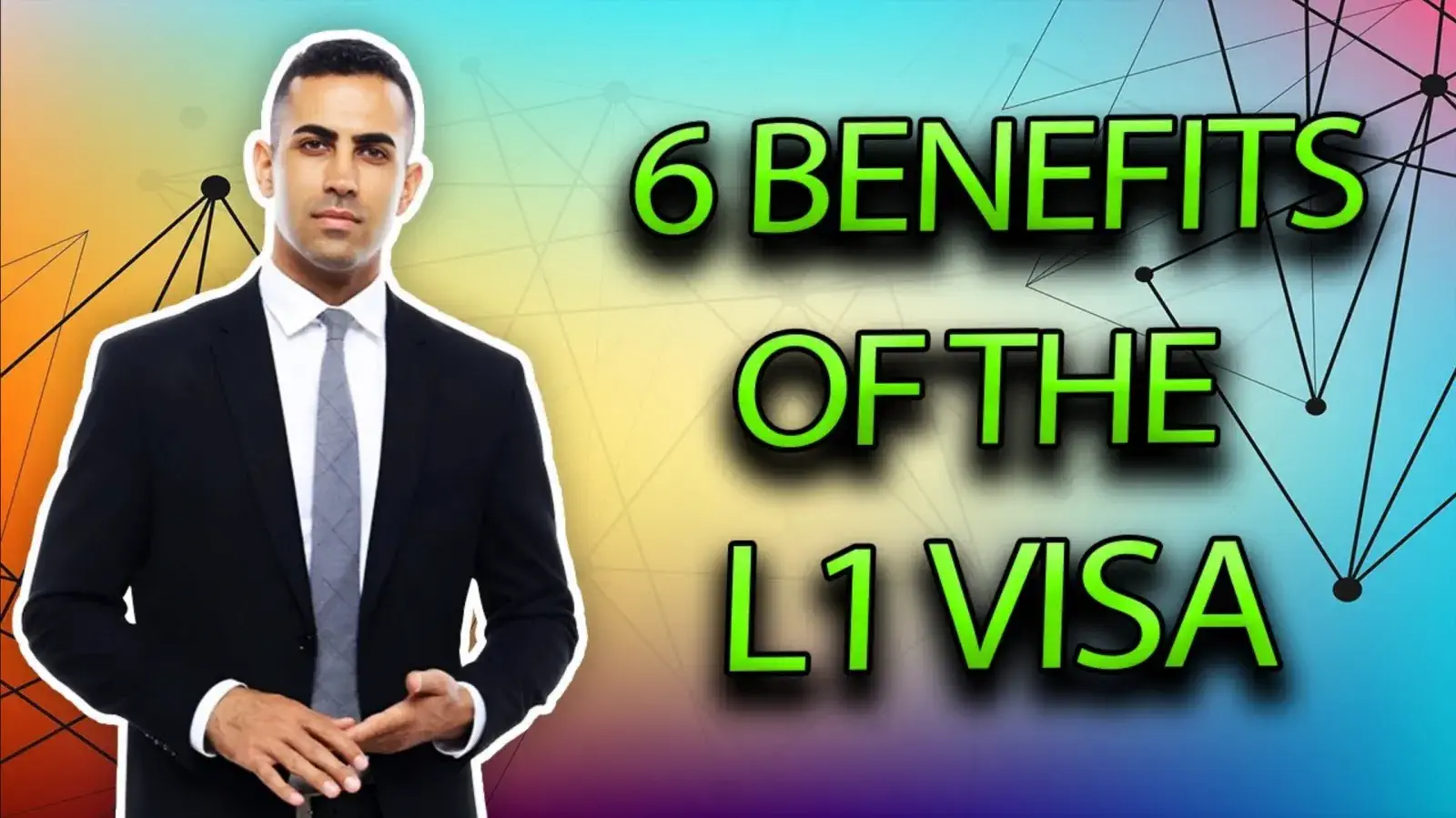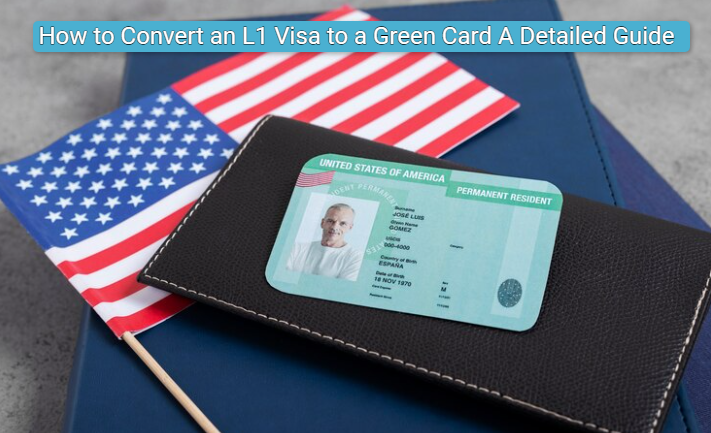Unlocking Opportunities: A Comprehensive Overview to the L1 Visa Process
The L1 visa procedure presents a vital path for international business seeking to move crucial workers throughout borders. Understanding the subtleties of qualification criteria, the distinctions in between L-1A and L-1B visas, and the intricacies of the application process can significantly affect an applicant's success. Nonetheless, maneuvering this facility landscape is not without its challenges, and careful focus to documents and employer sponsorship is crucial. As we check out the key parts of this process, the methods for getting over possible challenges will become obvious, exposing how informed preparation can open a globe of chances.
Recognizing the L1 Visa
Understanding the L1 visa requires identifying its importance as a crucial device for multinational firms seeking to move experienced workers between international offices. This non-immigrant visa group helps with the movement of execs, managers, and specialized understanding employees to the United States, thus allowing companies to preserve functional connection and harness worldwide skill successfully. The L1 visa is divided into two key classifications: L-1A for managers and executives, and L-1B for workers having specialized knowledge.The L1 visa serves a critical role in enhancing a company's affordable side in the global market. By permitting firms to transfer their crucial employees, companies can ensure that critical jobs are managed by certified individuals who are already acquainted with the firm's society and operational processes. L1 Visa. This internal transfer system not just cultivates expertise sharing but also promotes innovation and collaboration throughout borders.Moreover, the L1 visa is usually preferred for its relatively simple application process contrasted to other visa groups, as it permits dual intent, permitting holders to seek irreversible residency while on a short-lived copyright. This function makes the L1 visa particularly appealing for both companies and workers, as it simplifies the pathway for skilled experts to develop long-term residency in the United States
Eligibility Requirements
Qualification for the L1 visa depends upon numerous crucial standards that guarantee both the staff member and the employer satisfy specific credentials. This non-immigrant visa is designed for international companies to transfer workers from consular services to united state counterparts.Firstly, the employer must be a qualifying organization, which includes a parent company, branch, affiliate, or subsidiary of an U.S. organization. The firm has to have been doing business for a minimum of one year both in the U.S. and abroad. This guarantees that the company has adequate operational security and a reputable presence.Secondly, the employee should hold a managerial, executive, or specialized knowledge position. For L1A visas, the applicant must show supervisory or executive credentials, while L1B visas concentrate on specialized understanding pertaining to the company's products, services, or processes. Furthermore, the staff member should have helped the international entity for at least one constant year within the last 3 years prior to their application.Lastly, the staff member's function in the U.S. should line up with their previous setting, making certain that their abilities and knowledge are leveraged for the business's advantage.

Kinds Of L1 Visas
The L1 visa classification consists of 2 main kinds created to assist in the transfer of employees within international companies: the L1A visa for supervisors and executives, and the L1B visa for workers with specialized understanding. Each kind offers distinctive purposes and has specific eligibility criteria.The L1A visa is customized for individuals who hold managerial or executive settings within a firm. This visa allows high-level staff members to move to an U.S. branch, subsidiary, or affiliate of the very same organization. Candidates for the L1A visa should show that they have actually been utilized in a supervisory or executive capacity for at the very least one continuous year within the previous 3 years prior to their application. Additionally, this visa supplies a longer duration of remain, originally approved for 3 years, with the opportunity of extensions for approximately seven years.In comparison, the L1B visa is planned for experts with specialized expertise associated to the firm's items, solutions, or processes. To qualify, applicants have to show that their know-how is vital to the organization which they have helped a minimum of one continuous year within the last 3 years in a duty that required this specialized understanding. The L1B visa is initially provided for three years, with expansions offered for up to five years.Both visa types are vital for companies seeking to improve their global operations by leveraging skilled personnel, consequently advertising technology and effectiveness within the united state market.
Application Process
Guiding with the L1 copyright procedure entails numerous essential actions that have to be meticulously complied with to guarantee a successful outcome. The process starts with the united state company, who need to initially establish qualification by demonstrating a certifying connection with the foreign entity and confirming that the staff member fulfills the certain demands for the L1 visa classification being sought.Once qualification is validated, the employer starts the procedure by submitting Form I-129, the Petition for a Nonimmigrant Worker, with the United State Citizenship and Migration Provider (USCIS) This kind should be come with by a thorough summary of the task responsibilities to be executed, the business framework of both the U.S. and foreign entities, and the staff member's qualifications. It's vital to verify that all info is accurate and total, as omissions or inaccuracies can result in hold-ups or denials.Upon authorization of the I-129 application, the next step involves the staff member making an application for the L1 visa at a united state embassy or consulate in their home country. This phase calls for the completion of Type DS-160, the Online Nonimmigrant copyright, and scheduling a meeting. During the meeting, the applicant needs to present proof sustaining their qualifications and the employer's petition.After the visa is provided, the employee can enter the United States to operate in the designated duty. Overall, careful preparation and adherence to each action of the application procedure are crucial for a successful L1 visa result.
Needed Documents

Important Types Required
Navigating the L1 Visa process requires mindful attention to the essential forms and documentation essential for an effective application. The primary form needed is the Type I-129, Application for a Nonimmigrant Worker, which should be completed and submitted by the united state employer (L1 Visa Requirements). This kind describes the information of the work offer and the qualifications of the worker looking for the L1 Visa.Alongside Type I-129, the applicant will certainly need to full Form I-539 if accompanying member of the family are additionally looking for visas. Furthermore, the company needs to supply proof of the qualifying connection between the L1 Visa united state entity and the international entity, commonly necessitating the entry of business files such as write-ups of consolidation or economic statements.Moreover, it is necessary to include the L Category Supplement to Form I-129, which specifies the kind of L Visa being requested-- either L-1A for supervisors and executives or L-1B for employees with specialized expertise. Applicants must guarantee that all forms are authorized and dated suitably, as incomplete submissions can lead to hold-ups or rejections. Properly constructing these essential forms lays the structure for a smoother L1 copyright process
Sustaining Evidence Demands
Supporting documents is important for a successful L1 copyright, as it corroborates the claims made in the petition. Candidates should offer a range of papers to demonstrate eligibility for the visa, which is categorized right into 2 primary types: evidence of the certifying relationship between the U.S. and international entities and proof of the applicant's qualifications.To establish the relationship, candidates ought to submit paperwork such as business organizational charts, economic declarations, and evidence of possession. These records validate that the international business has a qualifying connection with the united state employer, whether as a parent firm, subsidiary, branch, or affiliate.For the candidate's qualifications, important papers consist of a comprehensive work letter from the foreign employer, describing the applicant's task title, duties, and period of employment. Furthermore, instructional credentials, such as levels and diplomas, ought to be given to prove the applicant's proficiency in the pertinent area.
Company Sponsorship Documents
Employer sponsorship papers play a vital role in the L1 copyright procedure, as they validate the U.S. company's dedication to the applicant's employment in the United States. These papers are essential for demonstrating the company's qualification to fund the applicant for the L1 Visa.Key papers normally needed include a detailed employment letter from the U.S. employer, which outlines the work title, responsibilities, and the nature of the employment relationship. Furthermore, the company needs to supply proof of the business's authenticity, such as organization licenses, tax returns, and business charts, showing the relationship between the U.S. entity and the international company.Furthermore, evidence of the employee's certifying partnership with the international business is required. This might consist of paperwork confirming the staff member's role in the international entity, such as pay stubs, employment contracts, or performance evaluations.
Typical Obstacles
Navigating the L1 visa procedure offers numerous usual obstacles that candidates ought to recognize (What Is L1 Visa). Key issues frequently include rigorous documentation demands, possible delays in processing times, and the requirement for strict legal conformity. Understanding these obstacles can assist candidates better prepare and reduce dangers throughout their copyright trip
Documents Needs
The L1 copyright process frequently presents significant challenges connected to paperwork requirements. Candidates have to provide comprehensive documentation to establish eligibility, which can lead to complication and potential hold-ups. Trick documents consist of evidence of a qualifying partnership in between the united state and international employer, proof of the candidate's work background, and thorough info concerning the job duty in the U.S.One usual obstacle is collecting adequate proof to show the nature of the certifying relationship. Firms typically battle to present clear business charts or monetary statements that highlight the connection in between the entities. Furthermore, ensuring that letters of support from employers precisely reflect the candidate's task obligations and credentials is crucial, as unclear summaries can lead to denials.Another problem occurs from the demand for comprehensive work summaries that align with the L1 visa groups. Candidates have to express not just their existing role however additionally their managerial or specific expertise duties plainly. This necessitates a complete understanding of both the applicant's position and the governing language utilized in L1 applications.
Handling Dead Time
Experiencing hold-ups in handling times is an usual challenge encountered by L1 visa applicants, typically resulting in aggravation and unpredictability. A number of variables add to these delays, including high application quantities, increased scrutiny of applications, and management backlogs within the U.S. Citizenship and Migration Services (USCIS) Applicants might find that processing times can vary greatly relying on the solution facility handling their application, as each center has its own workload and performance degrees. Additionally, the complexity of the applicant's situation, such as the demand for extensive paperwork or information, can better extend wait times.In some circumstances, issues associated with the candidate's present migration standing or previous visa history might also lead to added delays, as USCIS may call for further review or information. It is necessary for prospects to remain proactive during this period, maintaining open communication with their employers and legal agents to resolve any kind of possible concerns promptly.Understanding these processing time challenges can aid L1 visa candidates prepare for possible hold-ups and mitigate the impact on their shift and career plans. Persistence and diligence are essential virtues in steering this detailed process.
Legal Conformity Issues
Lots of L1 visa applicants run into legal conformity concerns that can complicate their journey towards getting the visa. Comprehending and adhering to the particular regulations established by the united state Citizenship and Migration Services (USCIS) is crucial. Common challenges consist of demonstrating the qualifying connection between the international and U.S. employers, as well as confirming that the applicant possesses the requisite specific expertise or supervisory capacity.Additionally, applicants must provide detailed documentation describing their job obligations, company framework, and financial feasibility of the U.S. entity. Insufficient or unreliable documents can result in hold-ups and even denials. Employers must also ensure that they follow labor regulations, including wage and functioning condition requirements, which can influence visa eligibility.Another typical concern involves keeping conformity with the terms of the visa as soon as given. Modifications in work status, task obligations, or company framework can demand amendments to the visa, which if not attended to without delay can cause lawful difficulties. Consequently, remaining informed regarding compliance requirements and seeking legal counsel when essential is important to navigate the intricacies of the L1 visa process effectively.
Tips for Success
Success in the L1 copyright procedure typically rests on meticulous prep work and attention to information. To boost your possibilities of approval, begin by thoroughly understanding the eligibility requirements for both the L1A and L1B visa groups. Review whether your position at the company qualifies as supervisory, executive, or specialized understanding, as this classification notably impacts your application.Next, collect comprehensive documents that substantiates your cases. This consists of organizational graphes, detailed job descriptions, and evidence of the business's operational structure. Clear and concise proof of the qualifying relationship in between the U.S. entity and the international entity is crucial. Verify that all documents are arranged rationally and presented in a specialist fashion, as this shows your dedication and seriousness regarding the application.Engage the solutions of an experienced migration lawyer that concentrates on L1 visas. Their know-how can prove very useful, guiding you with facility policies and assuring that all documents conforms with current regulations. Furthermore, prepare for the meeting by practicing solutions to common inquiries and being all set to discuss your duty and contributions to the firm in depth.
Frequently Asked Concerns
Can Household Members Accompany the L1 Visa Owner?
Yes, household members of L1 visa owners, including partners and single youngsters under 21, can accompany the key visa holder. They may likewise obtain L2 visas, which permit them to live in the USA.
How Much Time Can I Remain On an L1 Visa?
The L1 visa enables initial remains of up to three years, with the possibility of extension. L1A visa holders might stay for an optimum of seven years, while L1B visa owners can remain for five years.
Can L1 Visa Holders Apply for a copyright?
Yes, L1 visa holders can request an environment-friendly card. They might pursue permanent residency with employment-based categories, commonly calling for sponsorship from their company, given they satisfy the essential certifications and documentation needs.
What Occurs if My L1 copyright Is Rejected?
If your L1 copyright is rejected, you may receive a notice outlining the factors for rejection. You can seek to appeal the choice, reapply, or check out alternative visa alternatives based on your circumstances.
Are There Any Type Of Travel Constraints With an L1 Visa?
An L1 visa generally enables for global travel; however, re-entry to the united state rests upon preserving valid condition. Travelers ought to guarantee conformity with visa conditions to avoid issues upon return
Final thought
